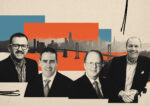
Trending
CBRE: Office tenants play “musical chairs” in Downtown SF
Companies often consolidate space across town in search of a “better seat”

Downtown San Francisco is poised to end the year with more than one of every four square feet of office space empty.
The city center has a vacancy rate of 27 percent, compared to 19 percent last year and nearly seven times the 4 percent rate for 2019, before the pandemic killed the office market, the San Francisco Chronicle reported, citing a preliminary report by CBRE.
Given an unsettled U.S. economy, the number of empty offices won’t change anytime soon, said Colin Yasukochi, executive director of CBRE’s Tech Insights Center.
Salesforce West, the 43-story office tower owned by Salesforce at 50 Mission Street, sits half-empty during the era of remote work. Its vacancy rate is 55 percent.
If it wasn’t for some major leases since last summer, when City Hall’s hopes of a large-scale return to the office by tech and other downtown firms fizzled out, the office vacancies would have been even worse.
Some 850,000 square feet is expected to be leased in the quarter ending on Dec. 31, Yasukochi said, compared to 782,000 for the prior three months.
Most of the activity reflects firms moving from one downtown office into another, often consolidating as they do so.
This month, global architecture firm Gensler leased 45,000 square feet in the historic Mills Building in the Financial District, but the firm will abandon 55,000 square feet in a highrise on Fremont Street.
“What you’re seeing right now, somewhat, is musical chairs,” said Yasukochi. “But you’re getting a better seat.”
The doldrums are expected to last six to nine more months, he said. There are fears of a recession, and many tech firms tied to San Francisco are laying off workers worldwide.
But the last half of 2023 could see a rebound — partly from the larger economy, he said, but also as large firms gain confidence about how they’ll operate in a post-pandemic environment.
“It’s hard to predict anything based on whatever is happening today,” Yasukochi told the Chronicle, since it still isn’t clear to what extent companies will require employees to return to work, or what a “new normal” might be.
Even so, “things could start picking up in the second half of next year,” he said.
— Dana Bartholomew
Read more






